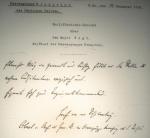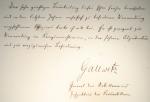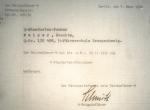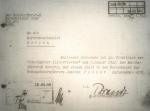-
Posts
4,908 -
Joined
-
Last visited
-
Days Won
97
Content Type
Profiles
Forums
Blogs
Gallery
Events
Store
Everything posted by Dave Danner
-
Wild von Hohenborn, Johann Heinrich Adolf 8.7.1860-25.10.1925 Generalmajor 4.6.12 Generalleutnant 20.1.15 Dir., Allg. Kriegsdepartment, 1913-14 Kdr. 30. Infanterie-Division, 1914 General-Quartiermeister, 1914-15 Kriegsminister, 1915-16 Komm. General, XVI. Armeekorps, 1916-19 Ritter des Ordens "Pour le Mérite" mit Eichenlaube (PLM EL) http://de.wikipedia....d_von_Hohenborn http://prussianmachine.com/akb/wild.htm
-
Schulenburg, Friedrich Bernhard Karl Gustav Ulrich Erich Graf von der 21.11.1865-19.5.1939 Oberstleutnant 2.9.13 Oberst 24.7.15 Generalmajor 12.6.18 Kdr, Regiment der Gardes du Corps Chef des Generalstabes des Gardekorps, 1914-16 Chef des Generalstabes der 5. Armee, 1916-17 Chef des Generalstabes der Heeresgruppe Deutscher Kronprinz, 1917-18 http://de.wikipedia....der_Schulenburg
-
Schubert, Louis Theodor Richard von 19.4.1850-13.5.1933 General der Artillerie 16.8.07 Generaloberst 27.1.17 Inspekteur der Feldartillerie, 1907-11 zur Disposition 4.4.11 Komm. General, XV. Reservekorps, 1914 Oberbefehlshaber der 8. Armee, 1914 Komm. General, XXVII. Reservekorps, 1914-16 Oberbefehlshaber der 7. Armee, 1916-17 http://prussianmachine.com/aok/schubert.htm
-
Schmidt von Knobelsdorf, Konstantin Heinrich 13.12.1860-1.9.1936 Generalleutnant 27.1.14 General der Infanterie 18.10.18 Oberquartiermeister im Gr. Generalstab u. Stellv. Chef des Generalstabes, 1912-14 Chef des Generalstabes der 5. Armee, 1914-1916 Komm. General, X. Armeekorps, 1916-1919 http://de.wikipedia....von_Knobelsdorf http://prussianmachine.com/akb/schmidt.htm
-
Sachsen-Meiningen, Friedrich Johann Bernhard Hermann Heinrich Moritz Prinz von, Herzog von Sachsen, Durchlaucht 12.10.1861-23.8.1914 Generalmajor 17.5.10 Generalleutnant 18.2.13 Kdr. 20. Feldartillerie-Brigade, 1907-13 Kdr. 39. Reserve-Infanterie-Brigade, 1914, gefallen http://de.wikipedia....chsen-Meiningen
-

Imperial 1914-1918 Kühne, Viktor
Dave Danner posted a topic in Germany: All Eras: Signature Database
Kühne, Otto Viktor 28.3.1857-9.2.1945 Generalmajor 22.3.12 G Generalleutnant 27.1.15 A Kdr., Feldartillerie-Schießschule, 1910-1913 Kdr., 30. Feldartillerie-Brigade, 1913-14 Kdr., 25. (Ghzgl. Hessische) Infanterie-Division, 1914-1916 Fhr., XII. (1. Kgl. Sächs.) Armeekorps, 1916 Komm. General, Generalkommando z.b.V. Nr. 54 u. Armee-Gruppe Kühne, 1916-17 Komm. General, IX. Reservekorps, 1917 Komm. General, XI. Armeekorps, 1917 Komm. General, V. Reservekorps, 1917 Komm. General, XI. Armeekorps, 1917-19 http://de.wikipedia....ktor_K%C3%BChne http://prussianmachine.com/aka/kuehne.htm -

Imperial 1914-1918 Kettembeil, Karl
Dave Danner posted a topic in Germany: All Eras: Signature Database
Kettembeil, Karl 1848-1916 Generalleutnant z.D. Kdr., Feldartillerie-Schießschule, 1904-10 zur Disposition 4.4.10 Kdr., 4. Ersatz-Feldartillerie-Brigade, 1914-? -

Imperial 1914-1918 Havenstein, Otto
Dave Danner posted a topic in Germany: All Eras: Signature Database
Havenstein, Otto Hermann 1859-1931 Oberst 1.10.12 O Generalmajor 22.3.15 R Generalleutnant a.D. Kdr. Niedersächsisches Feldartillerie-Regiment Nr. 46, 1911-14 Kdr. 20. Feldartillerie-Brigade, 1914-? Kdr. 21. Feldartillerie-Brigade, ?-1916 Kdr. 107. Infanterie-Division, 1916-19 -
Gündell, Theodor Wilhelm Gustav Erich von 13.4.1854–21.12.1924 Generalleutnant 17.9.09 General der Infanterie 16.6.13 (char., Pat. 2.9.14) zur Disposition 4.9.13 Kdr. 20. Division, 1910-13 Direktor der Kriegsakademie, 1913 Komm. General, V. Reservekorps, 1914-16 Komm. General, Armee-Abteilung B, 1916-18 http://prussianmachine.com/aok/guendell.htm
-

Imperial 1914-1918 Gallwitz, Max von
Dave Danner posted a topic in Germany: All Eras: Signature Database
Gallwitz, Max Karl Wilhelm von 2.5.1852-18.4.1937 General der Artillerie 4.4.11 Inspekteur der Feldartillerie, 1911-14 Komm. General, Garde-Reservekorps Oberbefehlshaber der Armeegruppe Gallwitz bzw. der 12. Armee, 1915 Oberbefehlshaber der 11. Armee, 1915-16 Oberbefehlshaber der 2. Armee, 1916 Oberbefehlshaber der 5. Armee, 1916-18 Oberbefehlshaber der Heeresgruppe Gallwitz, 1916-18 http://de.wikipedia....ax_von_Gallwitz http://prussianmachine.com/aok/gallwitz.htm -
Falkenhayn, Erich Georg Anton Sebastian von 11.9.1861-8.4.1922 Generalleutnant 7.7.13 General der Infanterie 20.1.15 kaiserl. osman. Generalfeldmarschall, 9.7.17 Kriegsminister, 1913-1915 Chef des Generalstabs des Feldheeres, 1914-16 Oberbefehlshaber der 9. Armee, 1916-17 Oberbefehlshaber der Heeresgruppe F, 1917-18 Oberbefehlshaber der 10. Armee, 1918-19 http://de.wikipedia...._von_Falkenhayn http://prussianmachine.com/aok/falkenhayn.htm
-

Imperial 1914-1918 Emmich, Otto von
Dave Danner posted a topic in Germany: All Eras: Signature Database
Emmich, Albert Theodor Otto von 4.4.1848-22.12.1915 General der Infanterie 29.5.09 Komm. General, X. Armeekorps, 1909-1915 Chef der Maasarmee, 1914 http://de.wikipedia....Otto_von_Emmich http://prussianmachine.com/aka/emmich.htm -
Walter Schmitt, born 13 January 1879, executed 18 September 1945. Standartenführer - 9.9.1934 Oberführer - 1.6.1935 Brigadeführer - 30.1.1936 Gruppenführer - 30.1.1937 Obergruppenführer - 20.4.1942 Personalreferent beim RFSS Chef der Personalkanzlei der SS Inspektor der SS-Junkerschulen Chef der Personalkanzlei im Persönlichen Stab des RFSS Leiter des SS-Personalhauptamtes Mitglied des Reichstags http://de.wikipedia....Schmitt_(NSDAP)
-
Rudolf Brandt, born 2 June 1909, executed 2 June 1948. 1936-37 Leiter des Persönlichen Stabes RFSS 1937-45 Persönlicher Referent des RFSS http://en.wikipedia....i/Rudolf_Brandt
-
I got his record. The file is fairly long, typical of officers of his rank, but I took photos of about a dozen of the most relevant pages, mainly his full curriculum vitae (Dienstlaufbahn) and his last few officer evaluation reports (Beurteilungen). The last entry in his Dienstlaufbahn says that he was appointed commander of Volks-Artillerie-Korps 404 on 1 March 1945. I suppose that's where he was when captured. These are the decorations listed in his Beurteilungen: Iron Cross 2nd Class on 17 May 1940 Iron Cross 1st Class on 31 May 1940 General Assault Badge in December 1940 Wound Badge in Black on 28 October 1941 Crimea Shield in December 1942 Only German decorations are usually listed in these Beurteilungen. However, from 1 January 1941 to the invasion of the Soviet Union in June, he was an instructor at the Romanian Artillery School, and from 22 June to 15 August 1941 he was liaison officer to several Romanian Army units in operations in Dobruja and the drive to Odessa. He then took command of Sturmgeschütz-Abteilung 190 until being wounded on 28 October. From 1 November 1942 to 19 July 1943, he commanded II. Abt./Art.-Regt. 42 in the Crimea. So it is possible that he also received one or more Romanian decorations.
-
For an officer, there are a number of ways. For an enlisted man, it was less common. Assuming Andreas is correct on his ribbon IDs, a scenario would be: native of Hamburg, living in Bavaria, serving in the Bavarian 21. Infanterie-Regiment. He gets the Iron Cross because he is German, the Bavarian Military Merit Cross because he is in the Bavarian Army, the Hamburg Hanseatic Cross because he is a native Hamburger, and the Mecklenburg Military Merit Cross because the Inhaber of his regiment was the Grand Duke of Mecklenburg-Schwerin.
-
I think your translation is basically correct, although I read it maybe as a little less firm. GM von Jordan is not saying he was definitely entitled, since the right to make awards was gone, but that he certainly ought to be entitled, and there was no objection to his applying for it, but as you say, the cross itself could not be delivered because of lack of stocks. I hate to say this, since I am a lawyer, but to me it comes across as kind of lawyerly: "you can go and get yourself the cross and wear it, because you earned it, but if anyone asks, i technically didn't award it to you, I just acknowledged that you earned it." Also, it's not technically from the military authority in Oldenburg, since that didn't exist in 1922, but the former military authority. Moritz von Jordan was the last Flügeladjutant to the Grand Duke of Oldenburg, and continued to act as his aide after the war.
-
#90 isn't Heinrich. He was already an Oberstleutnant in 1916 when the document is dated, and was promoted to Oberst on 18.7.17. He was commander of II./IR 115 before the war, but on mobilization he became commander of I./RIR 116. As I said, I am pretty sure this is his rather distant cousin Thilo Udo Max Eugen, Thilo, born 23.11.1869, was a junior Major on the staff of IR 115 in 1914, and he went to war with the regiment's Füsilier battalion. Thilo was a Major through most of the war, and was discharged on 11.10.17 as a char. Oberstleutnant (later getting the postwar "bump" to Oberst a.D.). As far as I can tell, the other Majors von Westernhagen on 12.9.16 were: Julius Theodor, Franco-Prussian War veteran, Maj.z.D. and Kdr. Mob. Etappen-Kommandantur 11, IV.A.K. Oskar Heinrich Helenus, Franco-Prussian War veteran, Maj.a.D., Lazarett-Zug Q1 Ernst Gustav Thilo, a Rittm.a.D., formerly with DR 14, promoted to char. Maj.a.D. on 22.5.15 while with the Mun.-Kol. u. Tr., XV.R.K., later with LIR 80 Friedrich August Christoph, Franco-Prussian War veteran, char. Maj.a.D. on 27.1.15, commander of several Landsturm battalions before his death in 1918. (2. LdstIB Dortmund VII/47, LdstIB Hersfeld XI/7, and 2.LdstIB Wesel VII/72). *******

















